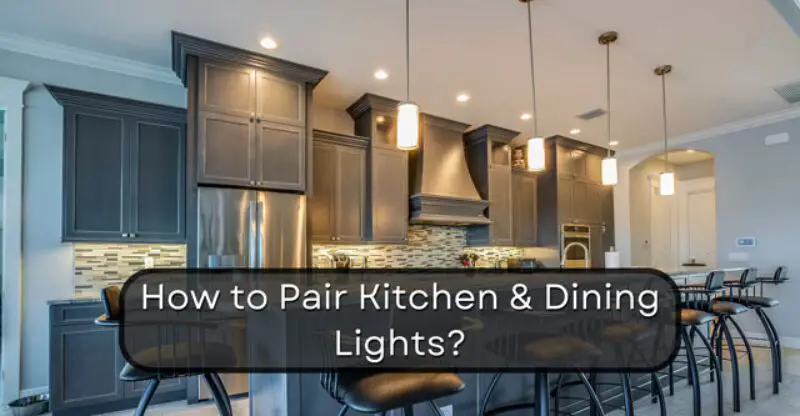How to Pair Kitchen and Dining Lights?
Are you wondering how to pair kitchen and dining lights to create the perfect lighting in your home? Lighting plays a crucial role in creating the desired atmosphere in our homes.
Lighting serves both functional and aesthetic purposes in the kitchen and dining areas. Proper lighting can enhance visibility and safety while creating a warm and inviting atmosphere.
When it comes to the kitchen and dining areas, finding the right lighting combination can enhance functionality and aesthetics.
In this article, we will explore various tips and ideas on how to pair kitchen and dining lights.
Assessing the Kitchen and Dining Spaces
Before selecting lighting fixtures, it’s essential to assess the layout and design of your kitchen and dining areas.
Take note of the available space, ceiling height, color scheme, materials, finishes, existing decor, and any architectural features that can influence your lighting choices.
This assessment will help you determine the overall style and type of lights that will complement your space.
For example, if you have a contemporary kitchen with stainless steel appliances and sleek finishes, opt for minimalist pendant lights or recessed lighting with a clean and modern design.
If your dining area features traditional furniture and warm wooden accents, consider a classic chandelier with warm light to enhance the traditional ambiance.
Explore Different Types of Fixtures
To achieve a well-balanced lighting design, it’s important to understand the various types of light fixtures available.
Here are some commonly used fixtures for kitchen and dining areas:
Wall Lights
Wall lights, also known as sconces, are an excellent choice for adding ambient or accent lighting. They can be installed on the walls, providing a soft glow and enhancing the overall ambiance of the room.
Wall lights are particularly useful for illuminating specific areas or artwork in your kitchen or dining area.
Close to Ceiling Lights
Close-to-ceiling lights, such as flush mounts and semi-flush mounts, are versatile options for general lighting in both kitchens and dining spaces.
They are mounted directly on the ceiling, providing ample illumination throughout the room. These fixtures come in various styles and designs, allowing you to choose one that suits your taste and blends with the overall decor.
Pendant Lights
Pendant lights are popular choices for adding a touch of elegance and style to kitchen islands or dining tables. They hang from the ceiling, typically suspended by a rod, chain, or cord.
Pendant lights come in a wide range of designs, sizes, and materials, allowing you to find the perfect match for your kitchen and dining area.
Chandelier Lights
For a grand and luxurious lighting statement, chandeliers are an excellent option. They add a touch of sophistication and drama to your kitchen or dining space.
Chandeliers are available in various styles, from traditional crystal designs to modern and minimalist options.
Consider the size and height of your space to choose a chandelier that fits perfectly without overwhelming the room.
Lighting Style
When choosing kitchen and dining lights, consider the lighting style you want to achieve. Different lighting styles create different moods and atmospheres.
Here are a few lighting styles to consider:
- Task Lighting: Task lighting focuses on providing ample illumination for specific tasks, such as food preparation, cooking, or reading recipes. Under-cabinet lights and pendant lights are commonly used for task lighting in kitchens.
- Ambient Lighting: Ambient lighting provides overall illumination to create a warm and welcoming atmosphere. Close-to-ceiling lights and wall lights are suitable for ambient lighting in both kitchens and dining areas.
- Accent Lighting: Accent lighting is used to highlight specific features or objects in the room, such as artwork, architectural details, or a focal point. Use wall lights or adjustable recessed lights to create stunning accents in your kitchen and dining space.
- Decorative Lighting: Decorative lighting adds a touch of style and visual interest to the room. Chandeliers, pendant lights, or unique statement fixtures can serve as decorative elements while providing functional lighting.
Determining the Desired Lighting Ambiance
Before selecting specific light fixtures, determine the desired lighting ambiance for your kitchen and dining area.
Do you prefer a bright and energizing atmosphere, or do you lean towards a cozy and intimate setting? The ambiance you want to create will guide your choice of light fixtures, bulb types, and dimming options.
For a vibrant and lively kitchen, opt for bright and cool lighting. LED lights with a higher color temperature are ideal for task lighting in the kitchen.
On the other hand, for a relaxed and inviting dining area, choose warmer light tones. Dimmable fixtures or smart lighting controls allow you to adjust the brightness according to the occasion and mood.
Choosing the Right Types of Light Fixtures for Each Area
Different areas within the kitchen and dining space require specific types of light fixtures to fulfill their purpose effectively.
Here are some considerations for choosing the right fixtures for each area:
Kitchen Island: Pendant lights or a row of small pendants are ideal for illuminating the kitchen island, offering functional lighting, and creating a visually appealing focal point.
Countertops and Workspaces: Under-cabinet lights or recessed lighting can effectively illuminate countertops and workspaces, ensuring sufficient light for food preparation and cooking tasks.
Dining Table: A chandelier or pendant lights suspended above the dining table create an elegant and inviting atmosphere, enhancing the dining experience.
General Lighting: Close-to-ceiling lights or track lighting can provide general illumination for the entire kitchen and dining area.
Layering the Lighting to Create Depth and Visual Interest
To create a visually dynamic and engaging space, consider layering the lighting. Layered lighting involves using different types of fixtures to achieve a balance of ambient, task, and accent lighting.
This technique adds depth and dimension to the room, making it more visually appealing. For example, combine recessed lighting for general illumination, pendant lights or chandeliers for focal points, and under-cabinet lights for task lighting.
Experiment with different combinations to find the perfect balance that suits your style and meets the functional requirements of your kitchen and dining area.
Considering Dimmers and Controls
Installing dimmers and controls gives you the flexibility to adjust the lighting intensity according to different occasions and activities.
Dimmers allow you to create a cozy and intimate atmosphere for dinner parties or a brighter setting for cooking and food preparation.
Having control over the lighting levels adds convenience and customization options to your kitchen and dining spaces.
Conclusion
Pairing kitchen and dining lights is an essential aspect of creating a comfortable and inviting living space. By following the steps outlined in this guide and exploring various lighting ideas, you can transform your kitchen and dining area into a well-lit and aesthetically pleasing oasis.
Remember to consider functionality, style, and energy efficiency while selecting and installing your lighting fixtures.
FAQs
Plan light fixtures based on kitchen layout and functions. Use a mix of ambient, task, and accent lighting to create a balanced and functional space.
Soft white or warm white light is best for kitchen ceilings as it provides a warm and inviting ambiance while maintaining good visibility.
Mixing different types of light fixtures adds visual interest and depth to the space. Just make sure they complement each other and align with the overall style and design.
LED lights are an excellent choice for kitchens and dining areas due to their energy efficiency, long lifespan, and versatility in color temperatures.



